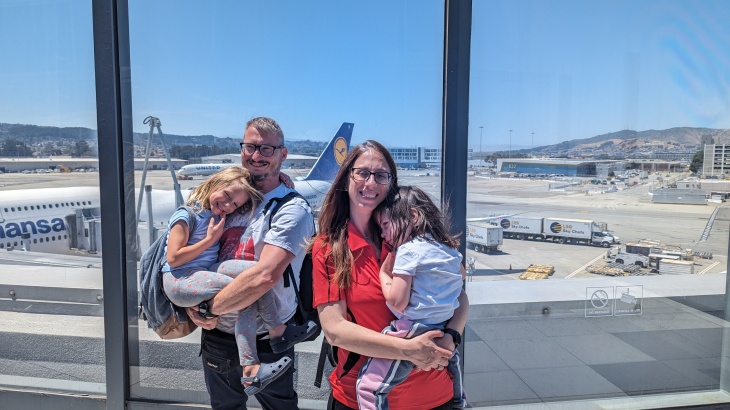Functional Materials for Sustainability
With the new institute director Dr Francesca Toma, the Institute of Photoelectrochemistry of the Helmholtz-Zentrum Hereon undergoes a content-related development and therefore has a new name since May 1, 2023: Institute of Functional Materials for Sustainability. Toma, who came to the research centre through a Helmholtz Distinguished Professorship, is moving from California to Berlin. At the beginning of July, she began her work in person an on site at the Hereon field office in Teltow.

Recently in Germany: Francesca Toma and her family.
How did the reorientation and thus also the renaming of the institute come about?
With the "artificial leaf", the institute is already successfully researching a sustainable method to produce hydrogen from sunlight in an environmentally friendly way. I will give even greater emphasis to this approach to sustainability and combine it with my expertise in materials research. In my opinion, we should focus more on sustainability in research in general. If we want to achieve the climate goals, our materials must not only serve climate protection, but must already be produced sustainably and be recyclable in the best possible way, with a cradle to cradle approach. Many materials - even if only in their production - are carbon-based and emit, among other things, large amounts of methane during the decomposition process, a green house gas that is potentially more threatening than CO2. Our goal, then, is to produce new materials that reduce greenhouse gas emissions and thus contribute to a sustainable future.
How do you want to achieve this goal?
In my institute, we characterise materials, investigate their interface interactions as they are working in real devices and in turn develop new, more climate-friendly materials on this basis. We test these, for example, for application in biomaterial research, and understand interactions between materials and biological cells or tissues.
The Institute's original research in the field of chemical photosynthesis will of course be maintained. In addition to biomaterial and hydrogen research, however, I would also like to cooperate with the other institutes at the centre - on the topic of sustainability, for example, with the Climate Service Center Germany (GERICS). The combination of materials and climate research within one centre is very rare and one of the reasons why I decided to work at Hereon.
Moving from California to Germany must have been a big transition. Have you settled in well now?
The move and the organisation that went with it was very smooth for us. My older daughter has just finished first year of school and both my daughters already have a place in Berlin for the next school year. They are very enthusiastic about the move to Germany. For me, it was important that their and our lives did not change overnight. I have been able to work mainly from California for the last few months, but I am now very happy to finally be on site for the long term.
What are your next steps?
With the new direction of the institute, the first thing will be to build up our structure internally and to strengthen the exchange with the other Hereon institutes. But then we also want to become better known externally. Because the new orientation underlines the holistic approach that has been characteristic of Hereon for a long time. And we need precisely this approach, in which the expertise of different research directions intertwines, in order to be able to tackle major challenges such as climate change.
Contact
Head of Institute
Phone: +49 (0) 4152 87-6201
Institute of Functional Materials for Sustainability
Helmholtz-Zentrum Hereon
Press Officer
Phone: +49 (0) 4152 87-1784
Communication and Media
Helmholtz-Zentrum Hereon
